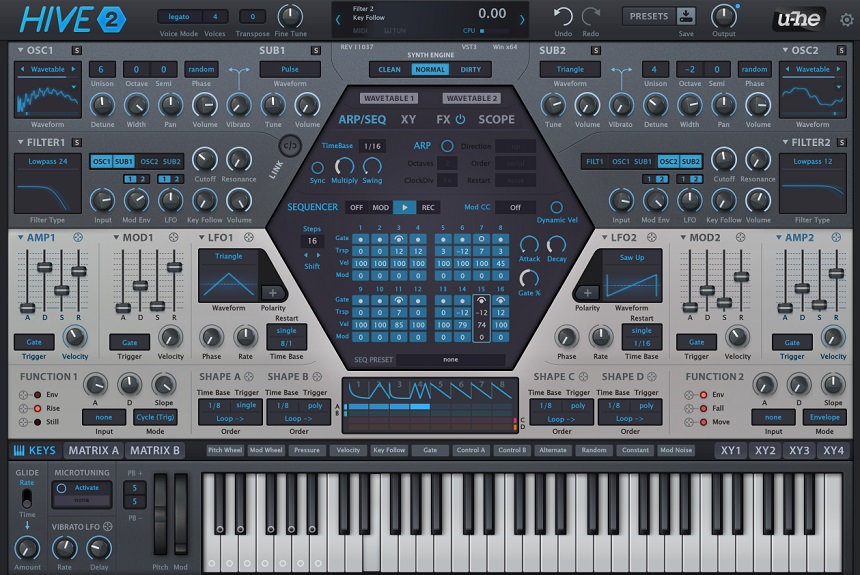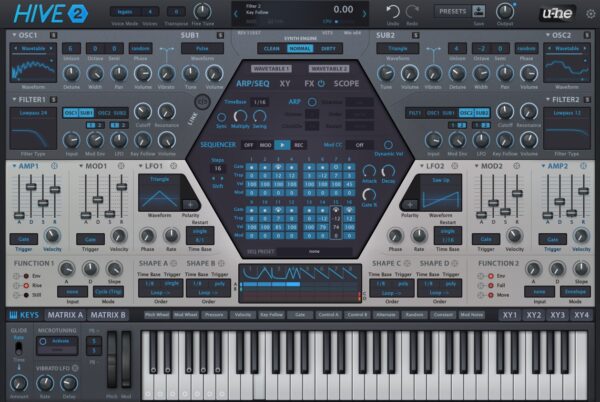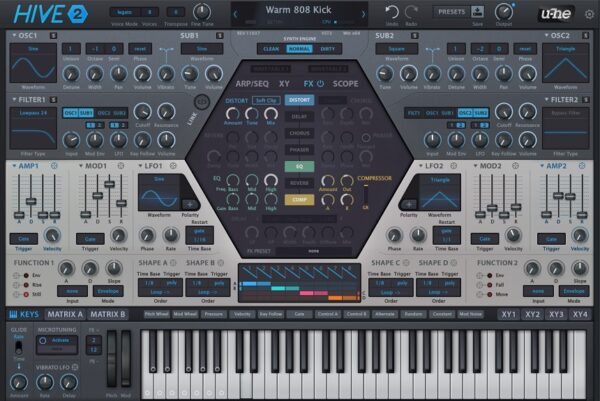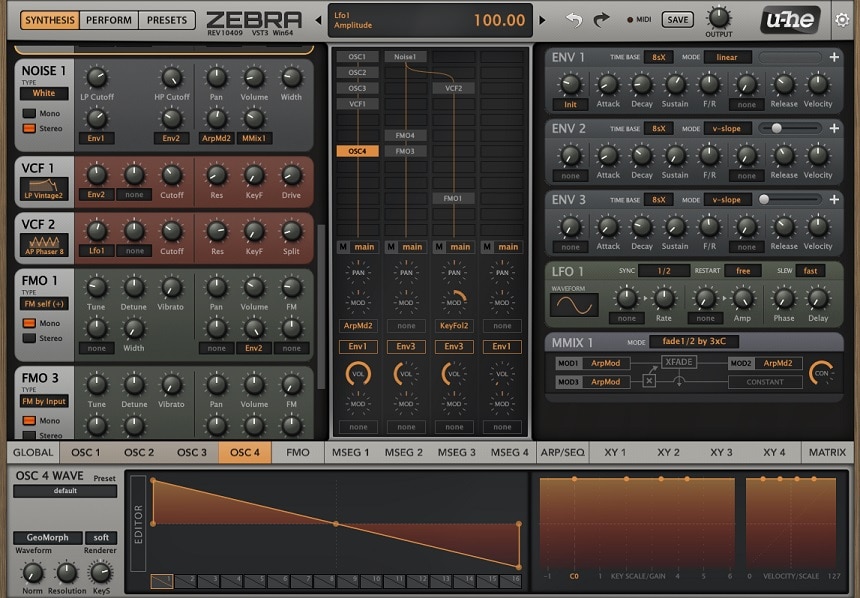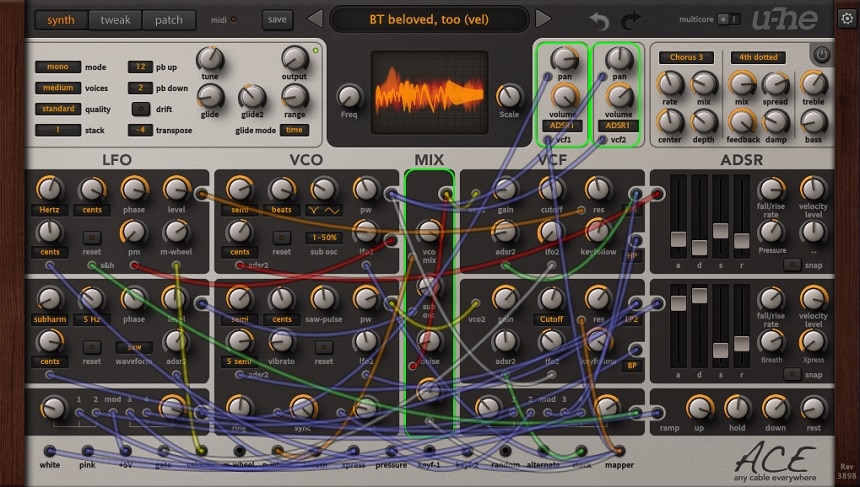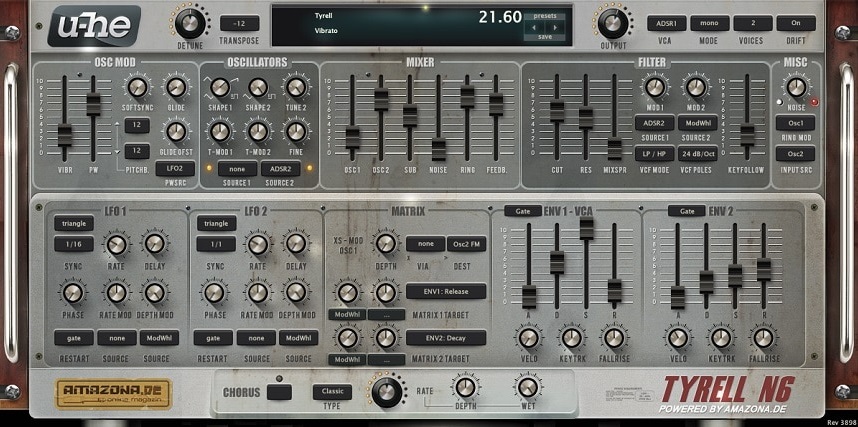1. u-he Hive 2
More Info & Price (Trial Available)
U-he launched Hive as a soft-synth with a synthesizer architecture similar to Sylenth and Spire, adding their twist & innovation to this incredible software.
Years later, in 2015, they launched Hive 2, with some upgrades and improvements, including the wavetable functionality.
It has two main oscillators on which a standard waveform or a wavetable can be loaded, with up to 16 voices of unison, two sub oscillators, three different synth engines, and most importantly, low CPU usage. Yes, the plugin is light on CPU, given its vast functionality.
Key Features:
- Extensive Synth Engine
You can choose from three different synth engines: Clean, Normal, and Dirty, each of which varies in its internal circuitry, envelope, oversampling, and detuning algorithms, and the choice of models of filters that are used. All these differences bring about a change in the fundamental characteristic of the sound.
- Huge Sound Bank
With about 2300 presets, from categories like basses, poly leads, mono leads, keys, pads, plucks, etc., the plugin packs a versatile range of sounds for different genres and purposes.
You can also save your presets and organize them by adding their tags (bright, dark, clean, phat, etc.), features (mono, poly, chord, etc.), and categories. A browser is also available for you to search the presets by their names and navigate through them.
- Good quality Sound Generators
The two main oscillators in the Hive2 can generate the following waveforms: saw, square, sine, triangle, half pulse, and narrow pulse, along with pink and white noise are of high resolution.
You can also load up a wavetable and choose a waveform from that table. In addition, you can load up your wavetables by saving the WAV file of that audio in the same directory as others. Wavetables can be further edited, by changing their phase, position, how they are looped, etc.
You can change any waveform’s detune, width, pan, volume, and vibrato settings. There are two filters with six different types of curves: Lowpass 12dB and 24dB/octave, Bandpass, Highpass, Bandreject, and Peaking, for different types of filtration. Resonance, cutoff frequency, and destination can be set for each of these.
- Immense scope for Programming & Processing
There’s a dedicated display section for the Arpeggiator and Sequence, called as “Arp/Seq” section. In the sequencer, you can load up to sixteen steps and add settings like Gate, Transpose, velocity, and Mod.
You can use the Mod value to assign modulating destinations to the Mod matrix. Two function generators sync the ADSR and adjust its curve as exponential or logarithmic.
For modulation, you can drag and drop any parameters with a crosshair symbol next to the destination of your choice. In addition, Hive 2 also allows you to quantize your signals using the scale quantizer. Further, there’s an X/Y pad also available for modulation.
The effects in the u-he are compressor, distortion, chorus, phaser, equalizer, delay, and reverb, and can be used in any sort that you like. In addition, the effects section has an aesthetic, colorful display that is pleasing to the eyes.
Lastly, the Scope (short form for Oscilloscope) section allows you to see the movement of your waveforms by simply dragging and dropping them onto it.
- Advanced Interpolation algorithms
Hive provides four different algorithms for interpolating between the frames: switch (sudden jumps between frames), crossfade (smooth interpolation between waveform magnitudes), spectral (smoothly interpolates between waveform magnitudes and phase), and zero phases (like spectral, but phase adjusts each partial to zero first).
- Structured visual display
You get a fairly organized structure of the subtractive synthesis process, with everything loaded on a single window, easily switchable tabs and sections like fx, scope, seq/arp, etc., and laid out amps and LFOs and their knobs and sliders. The signals are also easy to route with an easily understandable signal flow.
Compatibility:
The minimum OS requirement for the Hive 2 is a Mac OS X 10.7, a Windows 7+, or Linux. It is available in AU, VST2, VST3, AAX (Pro Tools 10.3.7+), and NKS with 32-bit and 64-bit versions).
However, the latest version of Avid’s toolkit for building AAX plugins is not compatible with the Apple SDK needed to build plugins for Apple’s new ARM/M1 processors. Therefore, the updated AAX versions are not compatible with macOS, Intel CPUs, and Apple M1.
Summary:
The best part about Hive 2 is its low CPU usage, its wide range of scope in its overall functionality, and its well-thought-out GUI. Also, the official manual for the plugin released by u-he is well-made and informative.
There’s a lot that you can do with the plugin, and if you may not understand the process of synthesis and sound design, there is a huge library of presets arranged based on various categories and styles you could choose from.
2. u-he Repro 1
More Info & Price (Trial Available)
Repro 1 is u-he’s take on the esteemed Prophet 5 synth’s monophonic counterpart featuring component-level modeling.
After releasing Diva, an acclaimed analog modeling synth, u-he turned their eyes to the Sequential Circuits’ hit synthesizers from the 1980s: the Prophet 5 and Prophet Pro One.
The resulting plugins were the Repro bundle, including two synths: Repro 5 and Repro 1. Repro 5 is an eight-voice polyphonic synth, whereas Repro 1 is proudly monophonic.
The main user interface of Repro 1 resembles the Pro One synth, especially how the parameters are laid out. Although, you’ll undoubtedly find plenty of modern changes introduced by u-he.
The fundamentals of the synth are fairly basic, which is expectable from a synth designed nearly four decades ago. However, exciting features like Tweaks and Sequencer, not to mention a preset collection, help make the synth as relevant as ever.
Key Features:
- Multi-mode Oscillators
Repro 1 features two oscillators, each capable of generating one or multiple types of waveforms. Oscillator A generates saw and pulse waves, whereas Oscillator B generates saw, triangle, and pulse waves.
You can change each oscillator’s frequency (pitch), octave, and pulse-width to control the cycles of the pulse wave. Furthermore, you can hard-sync the Oscillator A to Oscillator B with a toggle. You’ll find a switch that changes the Oscillator B into “Lo Freq,” which slows the oscillator down to inaudible speeds.
This feature lets you use the second oscillator as an LFO. The typical oscillator features are in the Mixer and Glide section. The Mixer section lets you change the volume of each oscillator and add a feedback circuit to boost the bass or introduce white noise.
- Filter & Modulation
Repro 1 features a single four-pole (24 dB/oct) low-pass filter, a replica from the original hardware. The filter includes keyboard tracking and a dedicated filter envelope. The exciting part is that you can use the filter envelope as a modulator.
You’ll also find the following modulators: Oscillator B’s Lo Freq LFO and a dedicated LFO. The three modulators can modulate oscillators’ frequency, pulse width, and filter cutoff frequency.
- Arpeggio & Sequencer
The main interface of the plugin sports a primitive arpeggiator that lets you switch between up and up-down modes. So, like with the original hardware, you’ll also find a sequencer.
As groundbreaking as the original hardware’s sequencer was for its time, u-he’s design surpasses the original on every front.
For starters, the sequencer lets you add two 32-step patterns per instance of the plugin, resulting in sixty-four total steps.
Furthermore, editing the sequencer is straightforward and features multiple types of steps with adjustable velocity per step. Moreover, you can save the patterns separately and copy the patterns between multiple instances of Repro 1. Of course, if you’d rather record the steps, you can do so straight from the Arpeggiator panel.
- Tweaks
Switch to the Tweaks panel, and you’ll essentially remove the synthesizer cover to reveal the components within. Here, you can change the very behavior of individual elements. You can try out different models for the oscillators, filters, etc. The filter models include crispy, rounded, driven, and poly, whereas the filter envelope features piano, one-shot, high sustain, etc.
Similarly, you can invert Oscillator B’s saw wave, make the LFO’s square and saw waves bipolar, and even set the filter cutoff to track the pitch-bend when keyboard tracking is enabled. Overall, while the main user interface is as clutter-free as possible, the Tweaks page is all about being extra with control.
- Stomp-Boxes
At the bottom right of the main user interface, you’ll find a tab called Effects, which takes the place of the virtual keyboard on the synth. You’ll find five effect processors in this section.
These effects include Jaws wave-folding distortion, Lyrebird delay, RESQ three-band EQ, Drench plate reverb, and Sonic Conditioner stere saturator & transient designer. You can reorder these plugins by dragging their names in the FX Chain list.
Compatibility:
U-he Repro 1 is available for Windows 7 or higher, macOS 10.9 or higher, and Linux, all 64-bit only. It comes in VST 2/3, AU, and AAX formats. Note that macOS AAX is temporarily unavailable at the time of writing.
Summary:
If you’re a fan of the Pro One synthesizer, u-he’s Repro 1 is pretty much the best emulation yet and probably in the future too.
It truly digs deep into the components of the synth to unearth every nuance and quirk the original hardware has while adding contemporary features like a comprehensive sequencer page, in-depth control over the sound, and high-quality effect processors.
Sure, it may not have the same flexibility as modern software synths. However, when it comes to creating mono leads, bass, and arpeggio patterns, Repro 1’s delightfully rich sounds might just come out on top for you.
3. u-he Diva
More Info & Price (Trial Available)
Diva, by u-he, offers limited controls, but it sounds very similar to real analog synths.
Overall, Diva is an easy plugin to navigate. The plugin gives you five different types of oscillators, four kinds of high-pass filters, five main filter options, and three types of envelopes. You’ll find LFOs, the effects, and the available controls in the lower panels, such as sync, pan, and tuning.
Additionally, there are individual menus for modifications, trimmers, scope, and presets.
Key Features:
- Oscillators
Each of the five types offers a slightly different GUI, which can be confusing. Other than that, they all sound incredible. For example, in the Voltage Controlled Oscillation area, the plugin gives you three options.
A CPU-hungry Triple VCO with FM controls, a multi-wave Dual VCO with PWM, and a CPU-friendly Dual VCO Eco with ring modulation. In addition to those, you get a DCO, a single oscillator with a flexible sub-OSC, and a Digital oscillator, which offers several types of waveforms.
- Filters
The heart of Diva is its filters. U-he has modeled all five units after a more significant number of classic hardware and, though the controls are similar, each has its unique flavor. For instance, VCF | BITE adds beautiful resonance by increasing the oscillator volume by 10%.
- Oscillator Voice Detune
Voltage oscillator synths detune slightly due to component wear, creating a natural effect that is almost like a soft chorus. To simulate this, u-he went above and beyond and gave us the Oscillator Voice Detune panel.
You can access it by clicking the Trimmers section at the GUI’s bottom. There are three knobs for each of Diva’s voices, and you can fine-tune them to find your sound. Additionally, you get a “Detune Amt” knob below in the same panel, which controls the global detune. In high values, the same note will sound highly different if you play it twice.
- Presets
The plugin gives you over 1200 presets, making life a lot easier, especially if you don’t have time to design your patches. Additionally, it’s easy to search for the right presets through tags or text. You can look up categories, features, or the character of the desired sound.
Sound & Usability:
Like most analog gear, you lose some flexibility to gain character and personality. And even though this is a plugin, it makes every effort to get the best of the most famous hardware synths. As a result, this plugin’s sound is warm, round, and punchy from the get-go. Additionally, Diva’s usability is unique. That’s because u-he went for a genuinely analog look and feel for this plugin.
However, the overall UI looks a bit crowded, with small names for small knobs. There are no fancy graphs or metering here, simply the parameters laid down as knobs and faders on a clean background. For that matter, controlling the envelopes with faders will come as a new experience for those only used to digital synths.
Compatibility:
This plugin is available for macOS 10.7 or newer and Windows 7 or higher in VST, AU, and AAX formats.
Summary:
Built as an all-analog solution for your synth needs, u-he’s Diva lets you grasp the sound of the original hardware for a thin slice of their prices.
Unlike the originals, though, you can replace the modules and combine them to taste, just to remind you that you’re in the digital realm. Overall, Diva is a great-sounding plugin that will have a special place in your collection.
4. u-he Zebra2 (Wireless Modular)
More Info & Price (Trial Available)
Zebra2 is the definition of quality – whether it’s an intricate pad or a simple lead, it sounds like a true instrument.
This masterpiece by u-he is far more than a modular synth. It’s a laboratory for sonic discovery. You can combine freehand wavetables with FM synthesis or route traditional sounds through complicated comb filters to redefine sound designing. Despite being so complicated, though, Zebra2 manages to make the interface comprehensive.
Zebra2 features many modules that you can add to your patch. And in the center, you will find a matrix, where you can route each module to four stereo channels. You’ll find the modules you’ve added on either side of the matrix, and below them, you will find various other pages.
Key Features:
- Oscillators
Zebra2 employs 4 wavetable oscillators that support drawing wavetables freehand and using spectral shaping for additive synthesis. You also get a large, flexible editor to draw your wavetables.
Furthermore, there are 4 FM oscillators featuring eight waveforms rather than the traditional sine wave. You’ll find quadric sine, dual AM sine, half-sine, sine shift, etc. Each main oscillator also features various parameters, including general ones like the tune, detune, unison (up to 11x), etc.
However, the OSC effects are the most fun – you’ll find various processors that work on the oscillator to make it sound brighter, darker, or even cause complete turmoil. There are over 25 OSC FX.
- Filters
Zebra2 has 4 regular filter modules with 23 modes and 4 cross-modulation filters (XMF) with 15 modes. Most of the regular filter modes sound very smooth and analog-like, and the module has a dedicated drive knob.
However, the XMF modules are incredible. You can use two filters simultaneously in various modes, add distortion, and use FM via its extra input. There are five modes of distortion: XMF, Analogue, Biased, Eco, Folded. Here, the Biased mode emulates diode-based distortion, and the Folded mode introduces a Lo-Fi sound.
- Modulation
Zebra2 features 4 envelopes, 4 multi-stage envelopes generators (MSEG), 4 per-voice LFOs, and 2 global LFOs. The MSEG modules are envelope modules with 32 flexible segments instead of merely 4 (ADSR). Furthermore, Zebra2 also features 4 assignable XY pads, which are helpful during live performance to control multiple parameters at once.
- Mixing
You’ll find 21 effect processors in Zebra2. These include modulation FX, reverb, delay, compressor, parametric EQ, filters, etc. And you can apply up to six effects on either the master channel or on the 2 busses.
- Sequencer
Zebra2 has a 16-step sequencer that functions similar to analog sequencers. You can create complex arpeggios using not only notes but up to two-parameter modulations per step. Using the glide feature along with modulated filters can create growling basslines or elegant, evolving arpeggios in no time.
Compatibility:
The plugin is available for Windows 7 or higher 32-bit or 64-bit, macOS 10.9 or higher 64-bit only, and Linux. It comes in VST 2/3, AU, and AAX formats.
Summary:
You can probably tell how gigantic Zebra2 truly is, and the sheer scale of it makes it intimidating to most people. However, the attempt to keep Zebra user-friendly is still laudable. Since it uses a modular workflow, you will not see all of the parameters simultaneously. Instead, you can focus on merely what you need.
So, Zebra2 can remain as simple or as complex as you want. Furthermore, the sound of Zebra2 is exceptionally smooth and sounds “realistic.” So, I would suggest it for softer music genres, film scores, media sound design, etc. Overall, it’s one of the absolute best synths on the market.
5. u-he ACE
More Info & Price (Trial Available)
This plugin prioritizes the analog sound and provides a genuine hardware-like workflow.
ACE is an abbreviation for Any Cable Everywhere, and it stands up to its name. It’s a compact synth plugin that can be both simple and complex. It has up to 16-voice polyphony and a fully resizable UI.
Furthermore, there are over 920 factory presets, making it an outstanding choice for beginners. However, note that it’s not the most straightforward synth to use, although the manual makes it a breeze.
Key Features:
- Analog Sound
There are two oscillators modeled on analog hardware in the plugin. They produce saw and pulse waves with PWM, sync, internal ring and cross/frequency modulation. One of them can also generate a sub-oscillator.
Further, you can add up to 8-voice unison with ±2 octave individual detuning. At the bottom left, you’ll also find white and pink noise generators. Next, let’s talk about the filters. ACE employs two analog-style filters that support overdrive as well as self-oscillation.
- Modulators
ACE employs two envelopes and two LFOs. However, it also features a Mapping Generator on the Tweak page, which lets you draw shapes/patterns. You can use the shape for per-note modulation, step modulation, transform any modulation source, or even as the LFO 2 waveform. The generator syncs to the host to boot.
- Modular Nature
ACE is technically a semi-modular synth because of its fixed architecture. So, you can play it even without patching the cables. However, you can override the default routing by starting to patch. And as with hardware, you can use the signals from an LFO as an audio source and vice versa.
- Mixing
The plugin only features a few global effect processors: a chorus with four modes, a stereo delay, and a treble and bass control. The delay can be synced to the host without any patching.
Compatibility:
The plugin is available for Windows 7 or higher 32-bit or 64-bit, macOS 10.9 or higher 64-bit, and Linux. It comes in VST 2/3, AU, and AAX formats.
Summary:
ACE appears to be geared towards beginners, but it still might be too complicated out of the box. Experimenting with the cables is highly rewarding, but you do need to know what you are doing. That’s when the oscilloscope visualizer at the top of the interface comes in handy.
Furthermore, the portamento features multiple glide options, which I found super useful for basslines. Overall, thanks to its large number of presets and the detailed manual, I think it’s a worthy investment for beginners, who can use the presets while learning this evergreen instrument.
As a final note, though, ACE can be very CPU intensive because of its analog models.
6. u-he Podolski
Podolski is a free and simple virtual analog synthesizer by u-he.
It consists of one oscillator, one filter, one envelope, and an arpeggiator/sequencer, which contributes to its uncomplicated and streamlined workflow, makes it easy to use, and doesn’t load the system much. In addition, it has over 300 factory presets consisting of diverse and versatile sounds, from which you can select high-quality pre-made patches.
Key Features:
- Synth Engine
The envelope modes in the plugin include ADSR/HDSR, or linear/exponential, with sustain with a rise/fall control. In addition, oscillators can generate sawtooth, triangle, or pulse width modulation waves, with up to 16 voices of polyphony that you can play in mono, legato, or arpeggiator modes.
- Multi-mode Filters
The filters can be lowpass, bandpass, or highpass, with drive and FM controls that can thicken up the sound and create more movement. That can create the required G-Funk movements and textures.
Compatibility:
Podolski is available only in AUv2, VST2, and VST3 versions and requires Windows 7 or newer, Mac OS X 10.9 or newer, or a Linux system.
Summary:
The plugin is extremely light on CPU, and you could load up multiple instances of it without loading up the system. Its simplification is its beauty and can be easily tweaked to create West Coast chords, synth leads, and bass lines. The VCA-based envelope contributes to its warm analog sound. The editable arpeggiator gives you interesting ways to create new groovy sounds.
7. u-he Zebralette
Zebralette, by u-he, is a free, miniaturized version of a paid synth, the Zebra2, that keeps some of its goodies.
The plugin offers an oscillator, one envelope, 16 voices of polyphony, 2 LFOs, and three built-in effects. Additionally, you can use MIDI interfaces to control most of the plugin’s parameters. Zebralette was developed to work as a learning interface for the Zebra2, but it turned out to be a great synth on its own, thanks to its robust oscillator.
Key Features:
- Oscillator
The heart of Zebralette’s sound is the thorough Zebra2 Oscillator, which gives you all the expected controls, including 1, 2, 4, and 11 unison voices. The wavetables are shaped in the Wave Editor, and you get the ability to save your modifications by clicking the Presets button.
- Wave Editor
The big graph-like panel in the middle of the oscillator area is where you can create and edit up to sixteen wavetables in four different modes. There are two Morph Modes and two Blend Modes, each with distinctive build characteristics that add versatility to your oscillator. You can use the Wave knob to change and blend the wavetables.
- Morph Modes
These are handle-oriented shapers. In GeoMorph mode, you can add up to 32 handles to adjust the curvature to taste. In SpectroMorph, you’re not handling the waveforms but the harmonic spectrum. There are 1023 harmonics spread logarithmically across 10 octaves, and when all handles are at the same level, you get a sawtooth wave.
- Blend Modes
GeoBlend, the first mode, depicts the waveform, but each cycle is represented by 128 vertical bars. Thus, when you turn the Wave button, the waves are cross-faded. The next mode is SpectroBlend, in which the harmonic spectrum is depicted by 128 bipolar bars, which show the in-phase and anti-phase harmonics.
Sound & Usability:
Zebralette’s sound is shockingly interesting for a single oscillator synth, and with 300 presets, it’s also easy to get started with. The simplified interface makes for an easy-to-learn plugin, and the phaser and delay effects further its versatility. Moreover, adding the MSEG to this free plugin is astounding, making it possible to achieve crazier-than-normal sounds with this simple tool.
Compatibility:
This plugin is available for macOS 10.9 and newer, Linux, and Windows 7 or higher in VST, AAX, and AU formats.
Summary:
U-he’s Zebralette is not precisely a flexible plugin, but it offers enough control for you to bend it to your will and come up with unusual sounds of your own. Overall, it’s a beginner-friendly plugin that deserves a place in your toolbox.
8. u-he Tyrell N6
Tyrell N6 by u-he is a great synth for creating game audio and synthwave music, which comes with 580 factory presets.
Originally, a German music publication called Amazona wanted to create an affordable analog synth based on features and ideas from their readers but did not have the resources to. Fortunately, u-he took this concept and turned their idea into a free software synthesizer, which is how the plugin came into existence.
Key Features:
- Drift Mode for Realness
The analog nature of the sounds on the synth comes by switching the DRIFT mode on the top-right corner of the synthesizer. That is the secret sauce that gives the synth its vintage vibe.
The chorus effect at the bottom of the synth also adds to the richness and width of the sound, hence adding to the analog characteristics. In addition, the VCA Envelope also contributes to that.
- The unique sound of its self-modulating filter
Under the Filters section, there are two modulation knobs, which you can tweak to add modulations to this filter. In addition, you can use the “Mixer” window and adjust the volume sliders of its oscillators, ring modulation, and feedback.
- Great Sound Design Capabilities
Tyrell N6 consists of two oscillators, one noise generator, and a ring modulator with editable oscillator modes. On top of it, it has a dual filter related to Diva (another synth by u-he), two gated ADSRs (0ne of which is voltage controlled), two LFOs, a modulation matrix, MIDi-learn, resizeable interface, and a voltage-controlled filter.
Compatibility:
This soft-synth by u-he is not standalone software and requires a host application to run. It’s available as VST and AAX in Windows and AU Vol. 2, VST 2, and AAX in MacOS. It can run on Linux, Windows 7 (or newer), and Mac OS X 10.7 (or newer). A minimum of 1 GB of RAM is required to run it.
Summary:
Considered a hybrid between the u-he ACE synth and Juno-106, Tyrell N6 is one of the best free synthesizers, as it features a wide range of analog sounds in an organized and simplified interface. Lastly, the sophisticated analog modeling done in the software is evident when you listen to the sound of it.
Bonus: FX
u-he Twangström
More Info & Price (Trial Available)
Twangstorm is modeled after the built-in spring unit Bazille, with two more reverb tanks and additional new features.
The plugin has shakeable springs, which a parameter called twang can control, and the shake of the spring could also be modulated and automated.
It impersonates mechanical reverberations’ physics rather than impulse responses like other virtual reverb plugins. Also, it doesn’t try to recreate the sonic characteristics but rather formulates the mechanical characteristics of the physical unit.
It also adds a drive knob, a tone knob, a filter section, a modulation section, an envelope, an LFO, and a width & mix knob for more control and innovation. The GUI is attractive and resizeable, and the plugin contains 76 different factory presets to get started with it.
Key Features:
- Tone-shaping parameters
Multi-mode filters are available as high pass and low pass types and have a variable type blend. It can be set as pre or post-tank, with adjustable stereo and resonance knobs.
Further, for more heat and color, there are drive and tone knobs to add more flavors to the reverb sound. Finally, you can use the decay, density, and tone knobs to play around with the tail of the reverb, resulting in a unique character.
- Interesting Modulations
The modulation options in the plugin are powerful, along with a morphing filter, which makes the reverb sound wavy and dark and gives it more movement. There are up to four modulation assignments sufficient for a reverb plugin.
Compatibility:
The plugin is available in AAX, VST2, VST3, AU, and NKS formats and has operating system requirements of OS X 10.9 or later or Windows 7 SP1 or later. In addition, it has processor requirements of Intel Core i3 or higher, 4GB RAM or more recommended, and Intel Core i3 or higher, 4GB RAM or more recommended for Windows.
Summary:
Overall, tonally Twangstorm sounds low-mids heavy due to its guitar amps origin, which makes it sound dark, which somehow works for spring reverb, but may not always work.
Apart from that, it’s quite realistic and has a unique analog characteristic which is difficult to achieve in software reverbs. Though not versatile, it carves its niche and stands out as a one-of-a-kind reverb plugin.

Shaurya Bhatia, is an Indian Music Producer, Composer, Rapper & Performer, who goes by the stage name MC SNUB, and is also 1/2 of the Indian pop music duo, called “babyface”. A certified Audio Engineer & Music Producer, and a practicing musician & rapper for more than 6 years, Shaurya has worked on projects of various genres and has also been a teaching faculty at Spin Gurus DJ Academy.


